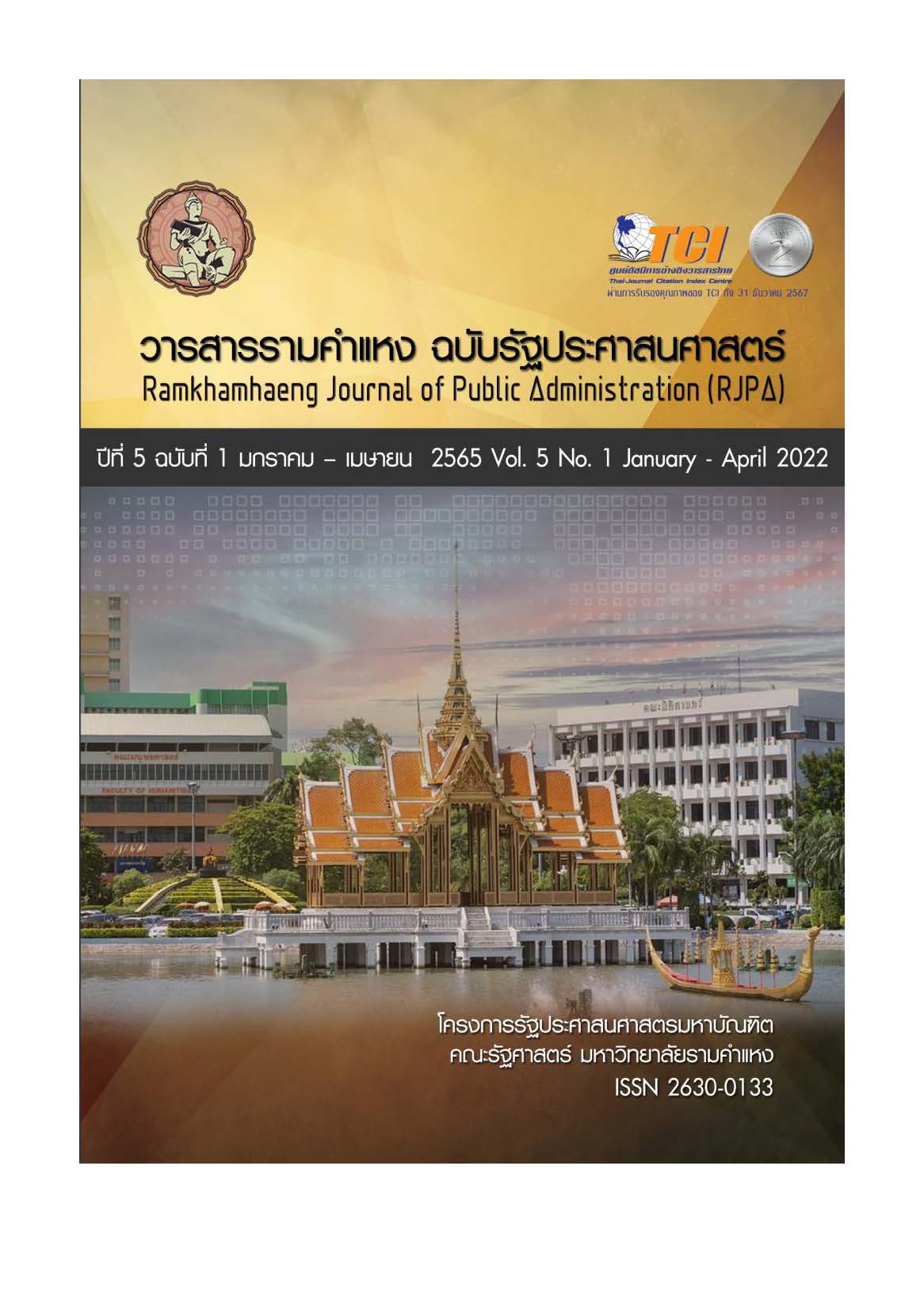ทัศนคติที่มีผลต่อประสิทธิผลของการใช้ระบบเทคโนโลยีสารสนเทศของหน่วยงานด้านสารสนเทศ กระทรวงการคลัง
คำสำคัญ:
ทักษะของผู้ใช้งานระบบเทคโนโลยีสารสนเทศ, ระดับของการใช้งาน ระบบเทคโนโลยีสารสนเทศ, ประสิทธิผลของการใช้ระบบเทคโนโลยีสารสนเทศบทคัดย่อ
งานวิจัยนี้มีวัตถุประสงค์เพื่อศึกษาทัศนคติที่มีผลต่อประสิทธิผลของการใช้ระบบเทคโนโลยีสารสนเทศของหน่วยงานด้านสารสนเทศในกระทรวงการคลังทั้งทางตรงและทางอ้อม โดยศึกษาตัวแปรเชิงสาเหตุ 4 ตัวแปร คือ 1) คุณสมบัติของผู้บริหารระดับสูง 2) ทักษะของผู้ใช้งานระบบเทคโนโลยีสารสนเทศ 3) ระดับของทรัพยากรเทคโนโลยีสารสนเทศ 4) ระดับของการใช้งานระบบเทคโนโลยีสารสนเทศ กลุ่มตัวอย่างในการวิจัยนี้คือ ผู้ปฏิบัติงานที่ใช้งานระบบเทคโนโลยีสารสนเทศของหน่วยงานด้านสารสนเทศในกระทรวงการคลัง จำนวน 120 คน ใช้การวิเคราะห์และประมวลผลโดยโมเดลสมการโครงสร้างตัวแบบเส้นทางกำลังสองน้อยที่สุด (PLS-SEM) ผลการวิจัยพบว่า คุณสมบัติของผู้บริหารระดับสูง ระดับของทรัพยากรเทคโนโลยีสารสนเทศ และระดับของการใช้งานระบบเทคโนโลยีสารสนเทศ มีความสัมพันธ์เชิงบวกกับประสิทธิผลของการใช้ระบบเทคโนโลยีสารสนเทศของหน่วยงานฯ อีกทั้งคุณสมบัติของผู้บริหารระดับสูง ทักษะของผู้ใช้งานระบบเทคโนโลยีสารสนเทศ และระดับของทรัพยากรเทคโนโลยีสารสนเทศ มีความสัมพันธ์ทางอ้อมเชิงบวกกับประสิทธิผลของการใช้ระบบเทคโนโลยีสารสนเทศของหน่วยงานฯผ่านระดับของการใช้งานระบบเทคโนโลยีสารสนเทศ นอกจากนี้คุณสมบัติของผู้บริหารระดับสูง ทักษะของผู้ใช้งานระบบเทคโนโลยีสารสนเทศ และระดับของทรัพยากรเทคโนโลยีสารสนเทศ มีความสัมพันธ์เชิงบวกกับระดับของการใช้งานระบบเทคโนโลยีสารสนเทศด้วยเช่นกัน ในขณะที่ทักษะของผู้ใช้งานระบบเทคโนโลยีสารสนเทศ ไม่มีความสัมพันธ์กับประสิทธิผลของการใช้ระบบเทคโนโลยีสารสนเทศของหน่วยงานฯ
เอกสารอ้างอิง
Aladwani, A. M. (2002). Organizational actions, computer attitudes, and end-user satisfaction in public organizations: An empirical study. Journal of Organizational and End User Computing (JOEUC), 14(1), 42-49.
Anandarajan, M., Igbaria, M., & Anakwe, U. P. (2002). IT acceptance in a less-developed country: a motivational factor perspective. International Journal of Information Management, 22(1), 47-65.
Briggs, R. O., Reinig, B. A., & de Vreede, G. J. (2008). The yield shift theory of satisfaction and its application to the IS/IT domain. Journal of the Association for Information Systems, 9(5), 14.
Byrd, T. A., & Turner, D. E. (2001). An exploratory analysis of the value of the skills of IT personnel: Their relationship to IS infrastructure and competitive advantage. Decision Sciences, 32(1), 21-54.
Fink, L., & Neumann, S. (2007). Gaining agility through IT personnel capabilities: The mediating role of IT infrastructure capabilities. Journal of the Association for Information Systems, 8(8), 25.
Gable, G. G., & Raman, K. S. (1992). Government initiatives for IT adoption in small businesses: experiences of the Singapore Small Enterprise Computerization Program. International Information Systems, 1(1), 68-93.
Hair, J. F., Jr., Black, W. C., Babin, B. J., & Anderson, R. E. (2010). Multivariate data analysis (7th ed.). Upper Saddle River, NJ: Prentice Hall.
Hair, J. F., Jr., Sarstedt, M., Matthews, L. M., & Ringle, C. M. (2016). Identifying and treating unobserved heterogeneity with FIMIX-PLS: Part I-method. European Business Review, 28(1), 63-76.
Hair, J. F., Ringle, C. M., & Sarstedt, M. (2011). PLS-SEM: Indeed a silver bullet. Journal of Marketing theory and Practice, 19(2), 139-152.
Hair Jr, J. F., Hult, G. T. M., Ringle, C. M., & Sarstedt, M. (2017). A primer on partial least squares structural equation modeling (PLS-SEM). Sage publications.
Igbaria, M., Zinatelli, N., Cragg, P., & Cavaye, A. L. (1997). Personal computing acceptance factors in small firms: a structural equation model. MIS quarterly, 279-305.
Kappelman, L. A. (1995). Measuring user involvement: A diffusion of innovation perspective. ACM SIGMIS Database: the DATABASE for Advances in Information Systems, 26(2-3), 65-86.
Mahmood, M. A., & Mann, G. J. (1993). Measuring the organizational impact of information technology investment: an exploratory study. Journal of management information systems, 10(1), 97-122.
Moon, M. J., Lee, J., & Roh, C. Y. (2014). The evolution of internal IT applications and e-government studies in public administration: Research themes and methods. Administration & Society, 46(1), 3-36.
Rouibah, K., Hamdy, H. I., & Al‐Enezi, M. Z. (2009). Effect of management support, training, and user involvement on system usage and satisfaction in Kuwait. Industrial Management & Data Systems, 103(9), 338-356.
Thong, J. Y., & Yap, C. S. (1995). CEO characteristics, organizational characteristics and information technology adoption in small businesses. Omega, 23(4), 429-442.
ดาวน์โหลด
เผยแพร่แล้ว
รูปแบบการอ้างอิง
ฉบับ
ประเภทบทความ
หมวดหมู่
สัญญาอนุญาต
ลิขสิทธิ์ (c) 2025 พัชรินทร์ ทิพยพลาติกุล

อนุญาตภายใต้เงื่อนไข Creative Commons Attribution-NonCommercial-NoDerivatives 4.0 International License.



